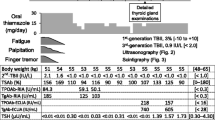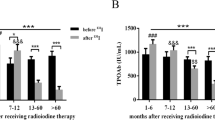Abstract
TSH receptor antibodies (TRAb) are believed to cause hyperthyroidism of Graves’ disease. Thyroid-stimulating antibody (TSAb) and TSH-binding inhibitor immunoglobulin (TBII) have been measured as TRAb to diagnose Graves’ disease and to follow Graves’ patients. We intended to evaluate the clinical value of TRAb (TSAb and TBII) assay in establishing the diagnosis of Graves’ disease and in predicting its clinical course. TSAb and TBII were studied in 686 normal subjects and in 277 Graves’ patients before antithyroid drug therapy. We followed serial changes of TSAb and TBII in 30 Graves’ patients before, during and after antithyroid drug therapy over 3.5–9 yr. We measured TSAb as a stimulator assay and TBII as a receptor assay. Both TSAb and TBII were distributed normally in 686 normal subjects. ROC curves demonstrated that both TSAb and TBII had high sensitivity and specificity for the diagnosis of Graves’ disease, and were equally sensitive and specific; 150% was chosen as cut-off value for TSAb and 10% for TBII. Of the 277 untreated Graves’ patients, 254 (92%) had positive TSAb and positive TBII. All of the 277 untreated Graves’ patients had positive TRAb (TSAb and/or TBII). We followed the serial changes of TSAb and TBII in 30 Graves’ patients over 3.5–9 yr. During antithyroid drug therapy, TSAb and TBII activities decreased and disappeared in 27 patients (Group A), but continued to be high in the other 3 (Group B). The former 27 Group A patients achieved remission, but the latter 3 Group B patients continued to have hyperthyroidism. Of the 27 Group A patients, 16 (59%) had parallel decreases of TSAb and TBII activities; in 6, the changes were predominantly observed in either TSAb or TBII, and in 4, complex changes in TSAb and TBII activities were observed. Disappearance of TSAb and appearance of TSBAb was seen in one. The other 3 Group B patients continued to have high TSAb and TBII activities and to have hyperthyroidism. In conclusion, TSAb and TBII are of clinical value in establishing the diagnosis of Graves’ disease and in predicting its clinical course. We clearly demonstrated its diagnostic usefulness. Both TSAb and TBII have high sensitivity and specificity. All of the 277 untreated Graves’ patients had TRAb (TSAb and/or TBII). Serial changes of TSAb and TBII during therapy differ from one patient to another, and can be classified into several groups. Changes in TSAb and TBII activities reflect the clinical courses of Graves’ patients. The simultaneous measurement of both TSAb and TBII is clinically useful, since TSAb and TBII reflect two different aspects of TRAb. TSAb and TBII are different.
Similar content being viewed by others
References
Adams D.D., Purves H.D. Abnormal responses in the assay of thyrotropin. Proc. Univ. Otago Med. Sch. 34: 11, 1956.
Rees Smith B., McLachlan S.M., Furmaniak J. Autoantibodies to the thyrotropin receptor. Endocr. Rev. 9: 106, 1988.
McKenzie J.M., Zakarija M., Sato A. Humoral immunity in Graves’ disease. Endocr. Metab. Clin. 7: 31, 1978.
Endo K., Kasagi K., Konishi J., Ikekubo K., Okuno T., Takeda Y., Mori T., Torizuka K. Detection and properties on TSH binding inhibitor immunoglobulins in patients with Graves’ disease and Hashimoto’s thyroiditis. J. Clin. Endocrinol. Metab. 46: 734, 1978.
Kasagi K., Konishi J., Iida Y., Ikekubo K., Mori T., Kuma K., Torizuka K. A new in vitro assay for human thyroid stimulator using cultured thyroid cells: effect of sodium chloride on adenosine 3′, 5′-monophosphate increase. J. Clin. Endocrinol. Metab. 54: 108, 1982.
Creagh F., Teece M., Williams S., Didcote S., Pekins W., Hashim F., Rees Smith B. An analysis of thyrotropin receptor binding and thyroid stimulating activities in a series of Graves’ sera. Clin. Endocrinol. (Oxf.) 23: 395, 1985.
Tamaki H., Amino N., Watanabe Y., Aozasa M., Hayashi H., Tachi J., Miyai K. Radioreceptor assay of anti-TSH receptor antibody activity: comparisons of assays using unextracted serum and immunoglobulin fractions and standardization of expression of activities. J. Clin. Lab. Immunol. 20: 1, 1986.
Wilson R., McKillop J.H., Henderson N., Pearson D.W., Thomson J.A. The ability of the serum thyrotropin receptor antibody (TRAb) index and HLA status to predict long term remission of thyrotoxicosis following medical therapy for Graves’ disease. Clin. Endocrinol. (Oxf.) 25: 151, 1986.
Reader S.C.J., Davison B., Beardwell C., Ratcliffe J.G., Robertson W.R. Protein A purified human immunoglobulins: a comparison of thyroid stimulating and thyrotropin receptor binding activities in thyrotoxicosis. Clin. Endocrinol. (Oxf.) 25: 441, 1986.
Kasagi K., Iida Y., Konishi J., Misaki T., Arai K., Endo K., Torizuka K., Kuma K. Paired determination of thyroid-stimulating and TSH-binding inhibitory activities in patients with Graves’ disease during antithyroid drug treatment. Acta Endocrinol. (Copenh.) 111: 474, 1986.
Rapoport B., Greenspan F.S., Filetti S., Pepitone M. Clinical experience with a human thyroid cell bioassay for thyroid stimulating immunoglobulin. J. Clin. Endocrinol. Metab. 58: 332, 1984.
Davies T.F., Platzer M., Schwartz A., Friedman E. Functionality of thyroid-stimulating antibodies assessed by cryopreserved human thyroid cell bioassay. J. Clin. Endocrinol. Metab. 57: 1021, 1983.
Madec A.M., Laurent M.C., Lorcy Y., Le Guerrier A.M., Rostagnat-Stefanutti A., Orgiazzi J., Allannic H. Thyroid-stimulating antibodies: an aid to the strategy of treatment of Graves’ disease? Clin. Endocrinol. (Oxf.) 21: 247, 1984.
Nagata A., Nakamura T., Ishige H., Sato Y., Uchimura H. Development of a kit for detection of thyroid stimulating antibody. Clin. Endocrinol. (Horumon To Rinsyo) (in Japanese) 41: 1023, 1993.
Campbell G. Advances in statistical methodology for the evaluation of diagnostic and laboratory tests. Stat. Med. 13: 499, 1994.
Rees Smith B., Hall R. Measurement of thyrotropin receptor antibodies. Meth. Enzymol. 74: 405, 1981.
Yoshimura H., Ito K., Uchimura H., Onaya T., Takasu N., Kasagi K., Yamashita K., Ochi Y., Yokoyama N., Nagataki S. Clinical evaluation of thyroid stimulating antibody (TSAb) by Yamasa TSAb kit. Clin. Endocrinol. (Horumon to Rinsyo) 42: 167, 1994 (in Japanese).
Mori T., Akamizu T., Kosugi S., Sugawa H., Inoue D., Okuda J., Ueda Y. Recent progress in TSH receptor studies with a new concept of “autoimmune TSH receptor disease”. Endocr. J. 41: 1, 1994.
Author information
Authors and Affiliations
Rights and permissions
About this article
Cite this article
Takasu, N., Oshiro, C., Akamine, H. et al. Thyroid-stimulating antibody and TSH-binding inhibitor immunoglobulin in 277 Graves’ patients and in 686 normal subjects. J Endocrinol Invest 20, 452–461 (1997). https://doi.org/10.1007/BF03348001
Accepted:
Published:
Issue Date:
DOI: https://doi.org/10.1007/BF03348001




